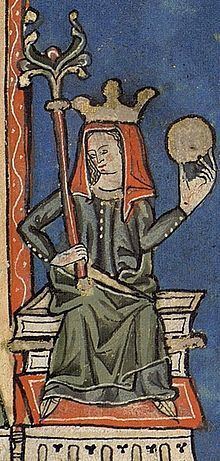Successor Afonso I Issue Afonso I of Portugal Name Theresa, of | Tenure 1096 – 12 May 1112 House House of Jimenez Role Political figure | |
 | ||
Reign 12 May 1112 – 24 June 1128 Burial Braga Cathedral, Braga, Portugal Died November 11, 1130, Montederramo, Spain Spouse Henry, Count of Portugal (m. 1093–1112) Children Afonso I of Portugal, Teresa Fernandez de Traba Parents Ximena Moniz, Alfonso VI of Leon and Castile Siblings Elvira of Castile, Countess of Toulouse Similar People Henry - Count of Portugal, Afonso I of Portugal, Alfonso VI of Leon and Castile, Urraca of Leon and Castile, Fernando Perez de Traba | ||
Teresa of le n countess of portugal
Teresa of León (Portuguese: Teresa; Galician-Portuguese: Tareja) (1080 – 11 November 1130) was Countess and Queen of Portugal. She rebelled against vassalic ties with her half-sister Urraca , was recognised as Queen by Pope Paschal II in 1116, but forced to accept Portugal's vassalage to León in 1121, although keeping her royal title. Her political and amorous affairs with Galician nobleman Fernando Pérez de Traba led to her ouster by her son, Afonso Henriques, who with the support of the Portuguese nobility and clergy defeated her at the Battle of São Mamede in 1128.
Contents
Birth and marriage

Teresa was the illegitimate daughter of King Alfonso VI of León and Castile by Jimena Muñoz. In 1093, her father married her to a French nobleman, Henry of Burgundy, nephew of Queen Constance, a brother of the Duke of Burgundy, a descendant of the kings of France in the male line. Henry was providing military assistance to his father-in-law against the Muslims on the Portuguese march.
In the first months of 1096, Henry and his cousin Raymond of Burgundy, husband of Queen Urraca, reached an agreement whereby each swore under oath that Raymond would give Henry the kingdom of Toledo and one-third of the royal treasury after King Alfonso's death and, if that was not possible, Henry would receive the kingdom of Galicia, while Henry, in turn, promised to support his cousin Raymond in securing all of the king's dominions and two-thirds of the treasury. King Alfonso, however, after becoming aware of this covenant, appointed Henry governor of all the land between the Minho River and Santarem, governed until then by Raymond, thereby limiting his son-in-law's government to Galicia. The two cousins then, instead of being allies, became rivals, each vying to obtain the king's favor. Upon the death of King Alfonso, Henry and Teresa continued governing these lands south of the Minho, and later, in December 1111 under the reign of Queen Urraca, were also governing Zamora.
Struggle with sister
At first, Teresa and Henry were vassals of her father, but Alfonso VI died in 1109, leaving his legitimate daughter, Queen Urraca of Castile as the heir to the throne. Henry invaded León, hoping to add it to his lands. When he died in 1112, Teresa was left to deal with the military and political situation. She took on the responsibility of government, and occupied herself at first mainly with her southern lands, that had only recently been reconquered from the Moors as far as the Mondego River. In recognizing her victory in defending Coimbra, she was called "Queen" by Pope Paschal II and in light of this recognition, she appears in her documents as "Daughter of Alphonso and elected by God", explicitly being called queen in an 1117 document, leading some to refer to her as the first monarch of Portugal.
In 1116, in an effort to expand her power, Teresa fought her half-sister, Queen Urraca. They fought again in 1120, as she continued to pursue a larger share in the Leonese inheritance, and allied herself as a widow to the most powerful Galician nobleman for that effect. This was the Fernando Pérez, Count of Trava, who had rejected his first wife to openly marry her, and served her on her southern border of the Mondego. In 1121, she was besieged and captured at Lanhoso, on her northern border with Galicia, fighting her sister Urraca. A negotiated peace was coordinated with aid from the Archbishops of Santiago de Compostela and Braga. The terms included that Teresa could go free only if she held the County of Portugal as a vassal of the Kingdom of León as she had received it initially.
Rebellions
By 1128, the Archbishop of Braga and the main Portuguese feudal nobles had had enough of her persistent Galician alliance, which the first feared could favour the ecclesiastical pretensions of his new rival the Galician Archbishop of Santiago de Compostela, Diego Gelmírez, who had just started to assert his pretensions to an alleged discovery of relics of Saint James in his town, as his way to gain power and riches over the other cathedrals in the Iberian Peninsula.
The Portuguese lords rebelled, and the Queen was deposed after a short civil war. Her son and heir, Afonso, defeated Teresa's troops at the Battle of São Mamede near Guimarães and led her, along with the Count of Traba and their children, into exile in the kingdom of Galicia, near the Portuguese border, where the Traba had founded the monastery of Toxas Altas. Teresa died soon afterwards in 1130. She was succeeded by her son, who would eventually lead Portugal into becoming a fully independent nation.
Issue
By Henry, Count of Portugal, Teresa had:
She had two daughters with count Fernando Pérez de Traba:
